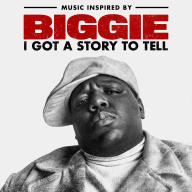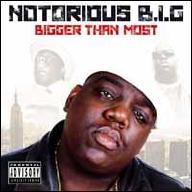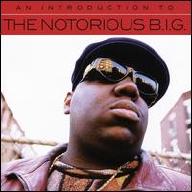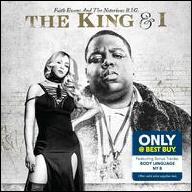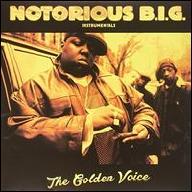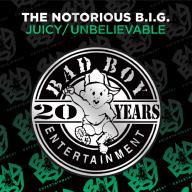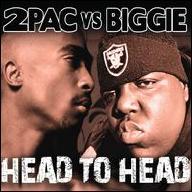The Notorious B.I.G. was born Christopher Wallace on May 21, 1972, and grew up in Brooklyn's Bedford-Stuyvesant neighborhood. He was interested in rap from a young age, performing with local groups like the Old Gold Brothers and the Techniques, the latter of whom brought the teenaged Wallace his first trip to a recording studio. He had already adopted the name Biggie Smalls at this point, a reference to his ample frame: he would grow to be over six feet tall and nearly 400 pounds. Although he was a good student, he dropped out of high school at age 17 to live life on the streets. Attracted by the money and flashy style of local drug dealers, he started selling crack for a living. He got busted on a trip to North Carolina and spent nine months in jail, and upon his release, he made some demo recordings on a friend's four-track. The resulting tape fell into the hands of Mister Cee, a DJ working with Big Daddy Kane; Cee in turn passed the tape on to hip-hop magazine The Source, which gave Biggie a positive write-up in a regular feature on unsigned artists. Thanks to the publicity, Biggie caught the attention of Uptown Records producer Sean Puffy Combs, who signed him immediately. With his new daughter in need of immediate financial support, Biggie kept dealing drugs for a short time until Combs found out and laid down the law. Not long after Biggie's signing, Combs split from Uptown to form his own label, Bad Boy, and took Biggie with him.
Changing his primary stage name from Biggie Smalls to the Notorious B.I.G., the newly committed rapper made his recording debut on a 1993 remix of Mary J. Blige's single "Real Love." He soon guested on another Blige remix, "What's the 411?," and contributed his first solo cut, "Party and Bullshit," to the soundtrack of the film Who's the Man? Now with a considerable underground buzz behind him, the Notorious B.I.G. delivered his debut album, Ready to Die, in September 1994. Its lead single, "Juicy," went gold, and the follow-up smash, "Big Poppa," achieved platinum sales and went Top Ten on the pop and R&B charts. Biggie's third single, "One More Chance," tied Michael Jackson's "Scream" for the highest debut ever on the pop charts; it entered at number five en route to an eventual peak at number two, and went all the way to number one on the R&B side. By the time the dust settled, Ready to Die had sold over four million copies and turned the Notorious B.I.G. into a hip-hop sensation -- the first major star the East Coast had produced since the rise of Dr. Dre's West Coast G-funk.
Not long after Ready to Die was released, Biggie married R&B singer and Bad Boy labelmate Faith Evans. In November 1994, West Coast gangsta star Tupac Shakur was shot several times in the lobby of a New York recording studio and robbed of thousands of dollars in jewelry. Shakur survived and accused Combs and his onetime friend Biggie of planning the attack, a charge both of them fervently denied. The ill will gradually snowballed into a heated rivalry between West and East Coast camps, with upstart Bad Boy now challenging Suge Knight's Death Row empire for hip-hop supremacy. Meanwhile, Biggie turned his energies elsewhere. He shepherded the career of Junior M.A.F.I.A., a group consisting of some of his childhood rap partners, and guested on their singles "Player's Anthem" and "Get Money." He also boosted several singles by his labelmates, such as Total's "Can't You See" and 112's "Only You," and worked with superstars like Michael Jackson (HIStory) and R. Kelly ("[You to Be] Happy," from R. Kelly). With the singles from Ready to Die still burning up the airwaves as well, Biggie ended 1995 as not only the top-selling rap artist, but also the biggest solo male act on both the pop and R&B charts. He also ran into trouble with the law on more than one occasion. A concert promoter accused him and members of his entourage of assaulting him when he refused to pay the promised fee after a concert cancellation. Later in the year, Biggie pled guilty to criminal mischief after attacking two harassing autograph seekers with a baseball bat.
The year 1996 was even more tumultuous. More legal problems ensued after police found marijuana and weapons in a raid on Biggie's home in Teaneck, New Jersey. Meanwhile, Junior M.A.F.I.A. member Lil' Kim released her first solo album under Biggie's direction, and the two made little effort to disguise their concurrent love affair. 2Pac, still nursing a grudge against Biggie and Combs, recorded a vicious slam on the East Coast scene called "Hit 'Em Up," in which he taunted Biggie about having slept with Faith Evans (who was by now estranged from her husband). What was more, during the recording sessions for Biggie's second album, he suffered rather serious injuries in a car accident and was confined to a wheelchair for a time. Finally, in September 1996, Tupac Shakur was murdered in a drive-by shooting on the Las Vegas strip. Given their very public feud, it didn't take long for rumors of Biggie's involvement to start swirling, although none were substantiated. Biggie was also criticized for not attending an anti-violence hip-hop summit held in Harlem in the wake of Shakur's death.
Observers hoped that Shakur's murder would serve as a wake-up call for gangsta rap in general, that on-record boasting had gotten out of hand and spilled into reality. Sadly, it would take another tragedy to drive that point home. In the early morning hours of March 9, 1997, the Notorious B.I.G. was leaving a party at the Petersen Automotive Museum in Los Angeles thrown by Vibe magazine in celebration of the Soul Train Music Awards. He sat in the passenger side of his SUV, with his bodyguard in the driver's seat and Junior M.A.F.I.A. member Lil' Cease in the back. According to most witnesses, another vehicle pulled up on the right side of the SUV while it was stopped at a red light, and six to ten shots were fired. Biggie's bodyguard rushed him to the nearby Cedars-Sinai Medical Center, but it was already too late. As much as Shakur was mourned, Biggie's death was perhaps even more shocking; it meant that Shakur's death was not an isolated incident, and that hip-hop's highest-profile talents might be caught in the middle of an escalating war. Naturally, speculation ran rampant that Biggie's killers were retaliating for Shakur's death, and since the case remains unsolved, the world may never know.
In the aftermath of the tragedy, the release of the Notorious B.I.G.'s second album went ahead as planned at the end of March. The eerily titled Life After Death was a sprawling, guest-laden double-disc set that seemed designed to compete with 2Pac's All Eyez on Me in terms of ambition and epic scope. Unsurprisingly, it entered the charts at number one, selling nearly 700,000 copies in its first week of release and spending a total of four weeks on top. The first single, "Hypnotize," went platinum and hit number one on the pop chart, and its follow-up, "Mo Money Mo Problems," duplicated both feats, making the Notorious B.I.G. the first artist ever to score two posthumous number one hits. A third single, "Sky's the Limit," went gold, and Life After Death was certified ten-times platinum approximately two years after its release. Plus, Combs -- now rechristened Puff Daddy -- and Faith Evans scored one of 1997's biggest singles with their tribute "I'll Be Missing You." In 1999, an album of previously unreleased B.I.G. material, Born Again, was released and entered the charts at number one. It eventually went double platinum. Six years later, Duets: The Final Chapter (studio scraps paired with new verses from several MCs and vocalists) surfaced and reached number three on the album chart.
In the years following Christopher Wallace's death, little official progress was made in the LAPD's murder investigation, and it began to look as if the responsible parties would never be brought to justice. The 2Pac retaliation theory still holds sway in many quarters, and it has also been speculated that members of the Crips gang murdered Wallace in a dispute over money owed for security services. In an article for Rolling Stone, and later a full-length book titled Labyrinth, journalist Randall Sullivan argued that Suge Knight hired onetime LAPD officer David Mack -- a convicted bank robber with ties to the Bloods -- to arrange a hit on Wallace, and that the gunman was a hitman and mortgage broker named Amir Muhammad. Sullivan further argued that when it became clear how many corrupt LAPD officers were involved with Death Row Records, the department hushed up as much as it could and all but abandoned detective Russell Poole's investigation recommendations.
Documentary filmmaker Nick Broomfield used Labyrinth as a basis for 2002's Biggie and Tupac, which featured interviews with Poole and Knight, among others. In April 2002, Faith Evans and Voletta Wallace (Biggie's mother) filed a civil suit against the LAPD alleging wrongful death, among other charges. In September of that year, the Los Angeles Times published a report alleging that the Notorious B.I.G. had paid members of the Crips one million dollars to murder 2Pac, and even supplied the gun used. Several of Biggie's relatives and friends stepped forward to say that the rapper had been recording in New Jersey, not masterminding a hit in Las Vegas; the report was also roundly criticized in the hip-hop community, which was anxious to avoid reopening old wounds. Outside legal matters, the B.I.G. legacy continued to be burnished with the 2007 compilation Greatest Hits, the 2009 biopic Notorious, and 2017's The King I. The third posthumous duets album, The King I was co-credited to Evans, whose new vocals were combined with a mix of familiar and previously unreleased verses from Biggie.
In 2019, to mark the 25th anniversary of his landmark Ready to Die, Rhino reissued the set as a deluxe box set that included photos and stories from the era. ~ Steve Huey, Rovi



